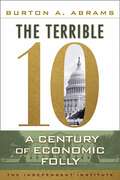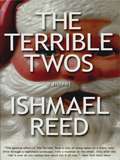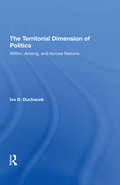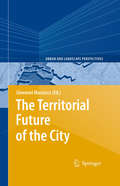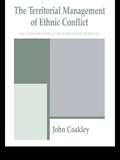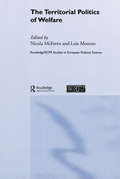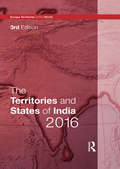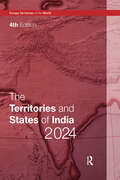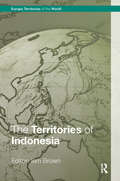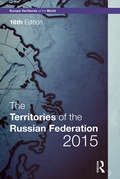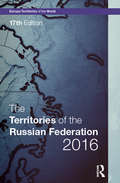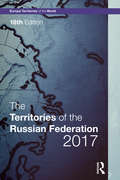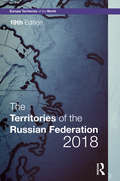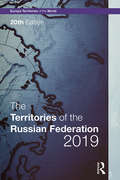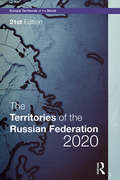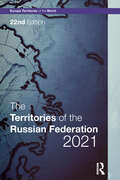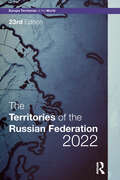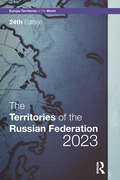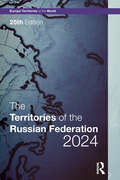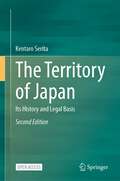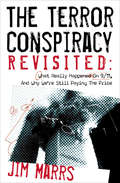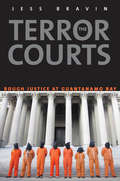- Table View
- List View
The Terrible 10: A Century of Economic Folly
by Burton A AbramsThe U.S. economy made impressive gains in the 20th century, but this progress makes it easy to forget a harsh reality: Americans were the victims of disastrous government policies that cost trillions of dollars in wasted resources, created mass unemployment, and kept millions of people in poverty who otherwise would have participated in the nation&’s growing prosperity.A complete dissection of the 10 most egregious economic blunders of the past century, this work provides the key lessons to help in avoiding such policy mistakes in the future. The Terrible 10 notes that, unlike the private sector, when the governance of the federal government fails, the role and scope of government is usually increased and that politicians from both parties tend to favor short-run benefits for friends while imposing costs on current and later generations. With issues and blame divided equally among Democrats and Republicans, this work stands as a highly readable history of how government economic blunders affect everyone.
The Terrible Kites of Len Yo
by Helena Clare PittmanTwo ancient Chinese rulers govern their kingdoms in very different ways. When Jen Fu attacks with brute force, Wu Ti fights back with cleverness. The battle is about to begin!
The Terrible Twos
by Ishmael ReedIshmael Reed's sixth novel depicts a zany, bizarre, and all-too-believable future where mankind's fate depends upon a jolly old gent named St. Nicholas and a Ristorasta dwarf named Black Peter, who together wreak mischievous havoc on Wall Street and in the Oval Office. This offbeat, on-target social critique makes marvelous fun of everything that is American, from commercialism to Congress, Santa Claus to religious cults.
The Territorial Dimension Of Politics: Within, Among, And Across Nations (Constitutional Government In Theory And Practice Ser.)
by Ivo D. Duchacek Helena DuchacekThis comparative study examines the dialectical tensions between global and regional interdependence and the fragmentation of humankind into territorial entities. Political authority may remain territory-bound, but borders increasingly are penetrated by pollutants, individuals, noncentral governments in search of foreign trade and investment, and transnational corporations, as well as the traditional exchanges of trade, media, and culture. The result of these transborder flows, accelerated by new technologies, is a new variety of international relations among “perforated sovereignties.†Dr. Duchacek analyzes the territorial organization of political authority in both democratic and authoritarian frameworks as well as in unitary and federal systems. Case studies focus on new forms of transborder interactions between neighboring countries, especially in North America and in Western Europe. The book is of major interest to scholars in the fields of political science and political economy. Quotations from a variety of political theorists and practitioners, illustrative diagrams, and maps make the book suitable for students of comparative politics, international relations, comparative federalism, and public policy.
The Territorial Dimension of EU Knowledge Policies: Higher Education Institutions for Europe (Routledge/UACES Contemporary European Studies)
by Alina J. Felder-StindtThis book expands our understanding of the so-far-overlooked territorial dimension of the EU’s knowledge policies crossing policy area boundaries.It examines how EU regional policy, endowed with substantial financial resources, influences the comparatively weakly endowed EU higher education policy. The analysis finds that (sub)national actors not only implement EU regional policy instruments but also actively shape EU policies. By showing this co-shaping transcends policy fields, the book provides new insights into the (feedback) effects of EU-funded cross-border cooperation. It shows that regionalization endeavours are political projects of regional and EU decision-makers, which remain exposed to Europeanization processes in the long term.This book is of key interest to scholars and students of European policymaking, EU integration, EU regional policies, EU public policy courses and more broadly to geography/development, social policy, governance and education policies.
The Territorial Future of the City
by Giovanni MacioccoThe volume brings together contributions by leading scholars and young academics with experience in the urban potential of the territory in situations not necessarily linked to the dense metropolis, its compact form or to city sprawl. What brings these scholars together is their common reflection on this central theme, though from varied disciplinary and experimental backgrounds. They offer new forms of representing social and spatial processes of the contemporary society.
The Territorial Management of Ethnic Conflict (Routledge Studies in Federalism and Decentralization #Vol. 9)
by John CoakleyThe object of this book is to look at the manner in which states attempt to cope with ethnic conflict through territorial approaches. This revised edition has new chapters covering Northern Ireland, South Africa and Yugoslavia.
The Territorial Peace: Borders, State Development, and International Conflict
by Douglas M. GiblerThere is continued discussion in international relations surrounding the existence (or not) of the 'democratic peace' - the idea that democracies do not fight each other. This book argues that threats to homeland territories force centralization within the state, for three reasons. First, territorial threats are highly salient to individuals and leaders must respond by promoting the security of the state. Second, threatened territories must be defended by large, standing land armies and these armies can then be used as forces for repression during times of peace. Finally, domestic political bargaining is dramatically altered during times of territorial threat; with government opponents joining the leader in promoting the security of the state. Leaders therefore have a favorable environment in which to institutionalize greater executive power. These forces explain why conflicts are associated with centralized states and in turn why peace is associated with democracy.
The Territorial Politics of Welfare (Routledge/ECPR Studies in European Political Science)
by Nicola Mcewen Luis MorenoThis is a major contribution to our understanding of European integration. It analyzes for the first time, in a highly systematic fashion, European integration as transnational political society formation in a common political space. Four conceptual chapters discuss different approaches to studying European 'transnationalization' including networks and socialization. Six empirical chapters provide in-depth studies of different aspects of this process and policy fields ranging from European party networks and university collaboration to informal economic governance in the Eurozone and police collaboration across borders. This book redresses the excessive concentration in EU research on supranational policy-making and inter-state bargaining. It will be of great interest to political scientists as well as contemporary historians, sociologists and lawyers.
The Territories and States of India 2016
by Europa PublicationsThis invaluable collection of information provides an in-depth guide to the regional dimension of the politics and economy of this vast and complex country. Incomparable in its coverage, which includes a detailed chronology for India as a whole, a bibliography, contact details for leading officials, and an historical account and economic survey for each of the twenty-nine states and seven territories, it supplies the reader with a more complete understanding of India as a whole.
The Territories and States of India 2024 (Europa Territories of the World series)
by Meena KhanThis invaluable collection of information provides an in-depth guide to the regional dimension of the politics and economy of this vast and complex country. Incomparable in its coverage, which includes a detailed chronology for India as a whole, a bibliography, contact details for leading officials, and an historical account and economic survey for each of the twenty-nine states and seven territories, it supplies the reader with a more complete understanding of India as a whole.
The Territories of Indonesia
by Iem BrownA new addition to Europa's popular 'Territories of the World' series, The Territories of Indonesia provides invaluable information on this diverse country. The book supplies an in-depth guide to both the regional dimensions of the area and its inter-provincial politics. Key Features: informative introductory essays provide an impartial background on regional aspects of the Republic a chronology covers the major events in the area's political and economic history including: colonial rule, independence, guided democracy, Suharto and recent terrorist activities information is provided about the national governments, structures and organizations. Individual chapters on each of the provinces and special districts, providing: a map of the area, with geographical and historical information an economic survey presenting the latest available statistics on performance and conditions in each of the provinces and districts a directory of the names and addresses of leading administrative and political officials. This key publication offers a unique insight into the relationship between provinces and central government within Indonesia.
The Territories of the Russian Federation 2015
by Europa PublicationsThis excellent reference source brings together hard-to-find information on the constituent units of the Russian Federation. The introduction examines the Russian Federation as a whole, focusing on Russian federalism and elections, followed by a chronology, demographic and economic statistics, and a review of the Federal Government. The second section comprises territorial surveys, each of which includes a current map. This edition includes new surveys covering the recently annexed (and disputed) territories of Crimea and Sevastopol, as well as updated surveys of each of the other 83 federal subjects. The third section comprises a select bibliography of books. The fourth section features a series of indexes, listing the territories alphabetically, by Federal Okrug and Economic Area. Users will also find a gazetteer of selected alternative and historic names, a list of the territories abolished, created or reconstituted in the post-Soviet period, and an index of more than 100 principal cities, detailing the territory in which each is located.
The Territories of the Russian Federation 2016
by Europa PublicationsThis excellent reference source brings together hard-to-find information on the constituent units of the Russian Federation. The introduction examines the Russian Federation as a whole, followed by a chronology, demographic and economic statistics, and a review of the Federal Government. The second section comprises territorial surveys, each of which includes a current map. This edition includes surveys covering the annexed (and disputed) territories of Crimea and Sevastopol, as well as updated surveys of each of the other 83 federal subjects. The third section comprises a select bibliography of books. The fourth section features a series of indexes, listing the territories alphabetically, by Federal Okrug and Economic Area. Users will also find a gazetteer of selected alternative and historic names, a list of the territories abolished, created or reconstituted in the post-Soviet period, and an index of more than 100 principal cities, detailing the territory in which each is located.
The Territories of the Russian Federation 2017
by 18th EditionThis excellent reference source brings together hard-to-find information on the constituent units of the Russian Federation. The introduction examines the Russian Federation as a whole, followed by a chronology, demographic and economic statistics, and a review of the Federal Government. The second section comprises territorial surveys, each of which includes a current map. This edition includes surveys covering the annexed (and disputed) territories of Crimea and Sevastopol, as well as updated surveys of each of the other 83 federal subjects. The third section comprises a select bibliography of books. The fourth section features a series of indexes, listing the territories alphabetically, by Federal Okrug and Economic Area. Users will also find a gazetteer of selected alternative and historic names, a list of the territories abolished, created or reconstituted in the post-Soviet period, and an index of more than 100 principal cities, detailing the territory in which each is located.
The Territories of the Russian Federation 2018
by Europa PublicationsThis excellent reference source brings together hard-to-find information on the constituent units of the Russian Federation. The introduction examines the Russian Federation as a whole, followed by a chronology, demographic and economic statistics, and a review of the Federal Government. The second section comprises territorial surveys, each of which includes a current map. This edition includes surveys covering the annexed (and disputed) territories of Crimea and Sevastopol, as well as updated surveys of each of the other 83 federal subjects. The third section comprises a select bibliography of books. The fourth section features a series of indexes, listing the territories alphabetically, by Federal Okrug and Economic Area. Users will also find a gazetteer of selected alternative and historic names, a list of the territories abolished, created or reconstituted in the post-Soviet period, and an index of more than 100 principal cities, detailing the territory in which each is located.
The Territories of the Russian Federation 2019
by Europa PublicationsThis excellent reference source brings together hard-to-find information on the constituent units of the Russian Federation. The introduction examines the Russian Federation as a whole, followed by a chronology, demographic and economic statistics, and a review of the Federal Government. The second section comprises territorial surveys, each of which includes a current map. This edition includes surveys covering the annexed (and disputed) territories of Crimea and Sevastopol, as well as updated surveys of each of the other 83 federal subjects. The third section comprises a select bibliography of books. The fourth section features a series of indexes, listing the territories alphabetically, by Federal Okrug and Economic Area. Users will also find a gazetteer of selected alternative and historic names, a list of the territories abolished, created or reconstituted in the post-Soviet period, and an index of more than 100 principal cities, detailing the territory in which each is located.
The Territories of the Russian Federation 2020
by Europa Europa PublicationsThis excellent reference source brings together hard-to-find information on the constituent units of the Russian Federation. The introduction examines the Russian Federation as a whole, followed by a chronology, demographic and economic statistics, and a review of the Federal Government. The second section comprises territorial surveys, each of which includes a current map. This edition includes surveys covering the annexed (and disputed) territories of Crimea and Sevastopol, as well as updated surveys of each of the other 83 federal subjects. The third section comprises a select bibliography of books. The fourth section features a series of indexes, listing the territories alphabetically, by Federal Okrug and Economic Area. Users will also find a gazetteer of selected alternative and historic names, a list of the territories abolished, created or reconstituted in the post-Soviet period, and an index of more than 100 principal cities, detailing the territory in which each is located.
The Territories of the Russian Federation 2021
by Dominic HeaneyThis excellent reference source brings together hard-to-find information on the constituent units of the Russian Federation. The introduction examines the Russian Federation as a whole, followed by a chronology, demographic and economic statistics, and a review of the Federal Government. The second section comprises territorial surveys, each of which includes a current map. This edition includes surveys covering the annexed (and disputed) territories of Crimea and Sevastopol, as well as updated surveys of each of the other 83 federal subjects. The third section comprises a select bibliography of books. The fourth section features a series of indexes, listing the territories alphabetically, by Federal Okrug and Economic Area. Users will also find a gazetteer of selected alternative and historic names, a list of the territories abolished, created or reconstituted in the post-Soviet period, and an index of more than 100 principal cities, detailing the territory in which each is located.
The Territories of the Russian Federation 2022
by Dominic HeaneyThis excellent reference source brings together hard-to-find information on the constituent units of the Russian Federation. The introduction examines the Russian Federation as a whole, followed by a chronology, demographic and economic statistics, and a review of the Federal Government. The second section comprises territorial surveys, each of which includes a current map. This edition includes surveys covering the annexed (and disputed) territories of Crimea and Sevastopol, as well as updated surveys of each of the other 83 federal subjects. The third section comprises a select bibliography of books. The fourth section features a series of indexes, listing the territories alphabetically, by Federal Okrug and Economic Area. Users will also find a gazetteer of selected alternative and historic names, a list of the territories abolished, created or reconstituted in the post-Soviet period, and an index of more than 100 principal cities, detailing the territory in which each is located.
The Territories of the Russian Federation 2023 (Europa Territories Of The World Ser.)
by Dominic HeaneyThis excellent reference source brings together hard-to-find information on the constituent units of the Russian Federation. The introduction examines the Russian Federation as a whole, followed by a chronology, demographic and economic statistics, and a review of the Federal Government. The second section comprises territorial surveys, each of which includes a current map. This edition includes surveys covering the annexed (and disputed) territories of Crimea and Sevastopol, as well as updated surveys of each of the other 83 federal subjects. The third section comprises a select bibliography of books. The fourth section features a series of indexes, listing the territories alphabetically, by Federal Okrug and Economic Area. Users will also find a gazetteer of selected alternative and historic names, a list of the territories abolished, created or reconstituted in the post-Soviet period, and an index of more than 100 principal cities, detailing the territory in which each is located.
The Territories of the Russian Federation 2024 (Europa Territories of the World series)
This excellent reference source brings together hard-to-find information on the constituent units of the Russian Federation.The introduction examines the Russian Federation as a whole, followed by a chronology, demographic and economic statistics, and a review of the Federal Government. The second section comprises territorial surveys, each of which includes a current map. This edition includes surveys covering the annexed (and disputed) territories of Crimea and Sevastopol, as well as updated surveys of each of the other 83 federal subjects. The third section comprises a select bibliography of books. The fourth section features a series of indexes, listing the territories alphabetically, by Federal Okrug and Economic Area. Users will also find a gazetteer of selected alternative and historic names, a list of the territories abolished, created or reconstituted in the post-Soviet period, and an index of more than 100 principal cities, detailing the territory in which each is located.
The Territory of Japan: Its History and Legal Basis
by Kentaro SeritaThis Open Access book carefully examines the legal and historical bases of the territory of Japan as a modern State from the Meiji period to 2002. A new preface summarizes key developments in the situation up through 2022.Japan’s current territory is stipulated by the Potsdam Declaration (1945) and the Treaty of Peace with Japan (1951); it includes the Northern Territories, the Senkaku Islands, and Takeshima. Japan has demanded the return of the Northern Territories, comprising the islands of Etorofu, Kunashiri, Shikotan and Habomai, which are occupied by Russia. China has claimed sovereignty over the Senkaku Islands, which are validly controlled by Japan; Japan has claimed sovereignty over Takeshima, which is occupied by the Republic of Korea.This book analyzes the current status of these territorial topics, drawing on historical documents and international legal precedent, and it suggests peaceful methods to address them. In discussing territorial land, sea, and air space, this work touches upon postwar concepts defining modern international law and relevant rules on these subjects—exclusive economic zones (EEZs), continental shelves, and air defense identification zones (ADIZs)—found in international treaties, such as the United Nations Convention on the Law of the Sea (UNCLOS), and related domestic laws.
The Terror Conspiracy Revisited: What Really Happened On 9/11, And Why We're Still Paying The Price
by Jim MarrsThe New York Times bestselling journalist and leading conspiracy writer presents his latest findings on the truth behind the 9/11 terror attacks. The terror attacks of September 11, 2001 ushered the United States into an era of war across the Middle East and government surveillance at home. In The Terror Conspiracy Revisited, Jim Marrs updates his authoritative dissection of the official story of 9/11. This revised edition is packed with explosive material including: The revelations of former New Jersey attorney General John Farmer, who served as Senior Counsel to the 9/11 Commission: "At some level of the government, at some point in time. . .there was an agreement not to tell the truth about what happened."Commission cochairman Thomas Kean's suspicion of deceit: "We to this day don't know why NORAD told us what they told us. It was just so far from the truth."The conclusion of European scientists that there was nanothermite in the World Trade Center debris, a high explosive generally available only through the US military.The investigation by Pilots For 9/11 Truth and their conclusion that hijackers could not have accessed the cockpit of Flight 77. One thing we know to be true is that the full truth about the September 11th attacks has not yet been presented to the American public. Jim Marrs thoroughly dismantles the credibility of the US government's narrative and leaves the reader with some unsavory but indisputable conclusionsesented to the American public. Jim Marrs thoroughly dismantles the credibility of the US government's narrative and leaves the reader with some unsavory but indisputable conclusions.
The Terror Courts
by Jess BravinSoon after the September 11 attacks in 2001, the United States captured hundreds of suspected al-Qaeda terrorists in Afghanistan and around the world. By the following January the first of these prisoners arrived at the U. S. military’s prison camp in Guantanamo Bay, Cuba, where they were subject to President George W. Bush’s executive order authorizing their trial by military commissions. Jess Bravin, theWall Street Journal’s Supreme Court correspondent, was there within days of the prison’s opening, and has continued ever since to cover the U. S. effort to create a parallel justice system for enemy aliens. A maze of legal, political, and moral issues has stood in the way of justice—issues often raised by military prosecutors who found themselves torn between duty to the chain of command and their commitment to fundamental American values. While much has been written about Guantanamo and brutal detention practices following 9/11, Bravin is the first to go inside the Pentagon’s prosecution team to expose the real-world legal consequences of those policies. Bravin describes cases undermined by inadmissible evidence obtained through torture, clashes between military lawyers and administration appointees, and political interference in criminal prosecutions that would be shocking within the traditional civilian and military justice systems. With the Obama administration planning to try the alleged 9/11 conspirators at Guantanamo—and vindicate the legal experiment the Bush administration could barely get off the ground—The Terror Courtscould not be more timely.
